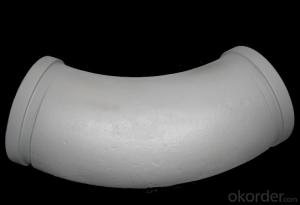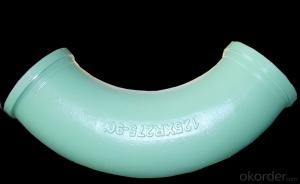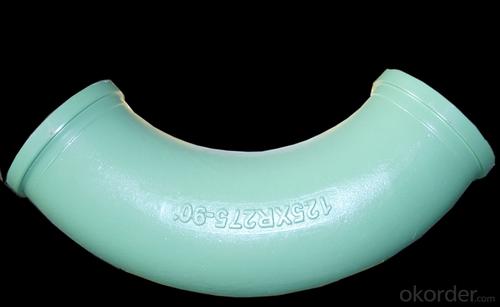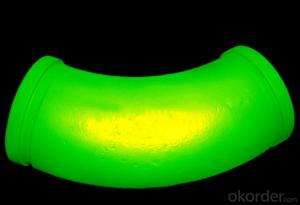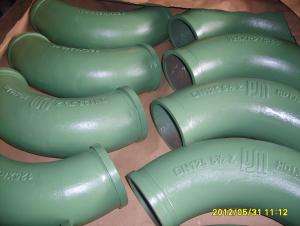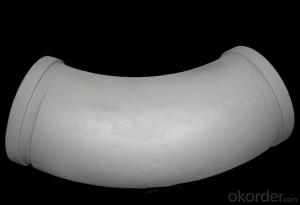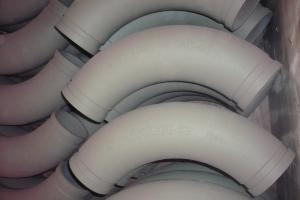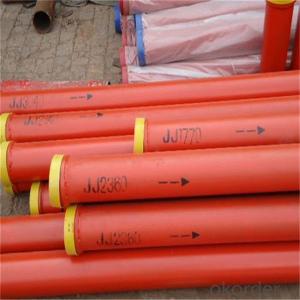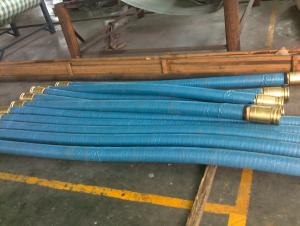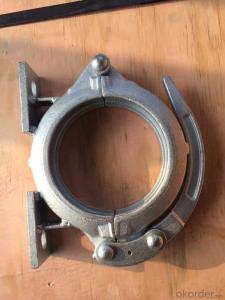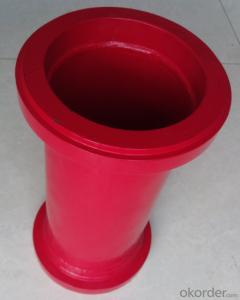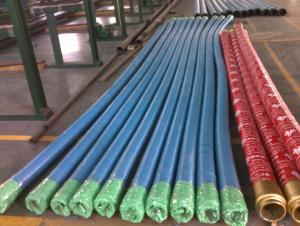Concrete Pump ELBOW R275, 45DGR DN125MM Grey
- Loading Port:
- Tianjin
- Payment Terms:
- TT or LC
- Min Order Qty:
- 10 pc
- Supply Capability:
- 5000 pc/month
OKorder Service Pledge
OKorder Financial Service
You Might Also Like
Product Name: Concrete Pump ELBOW R275, 45DGR DN125MM Grey with High Quality
1. Specification
Dimensions: DN100MM
Radius: 275mm,1000mm
Flange: SK, ZX, F&M
Degree: 30°, 45°, 90°
Material: #20 steel, ST52, Mn 13-4
Thickness: 4.5mm,6mm,7.1mm,7.5mm,10mm,
Working pressure: 180MPa
Notes: total series of concrete pump clamp for different brand concrete pump(PUTZMEISTER, SCHWING, CIFA, SANY, ZOOMLION, IHI, KYOKUTO Etc) available from us.
2. Application of Concrete Pump Bend DN125
Concrete Pump ELBOW R275, 45DGR DN125MM Grey widely used on concrete pump truck, concrete placing boom, trailer concrete pump etc, for concrete delivery pipe connection.
Our concrete pump bends have been successfully exported to many countries from 1998, Our main markets as below: Middle East, Southeast Asia, America, Brazil, Italy, Russia, South Africa etc
Aiming at the largest concrete pump parts manufacturer, and reliable, professional supplier in China, we can supply concrete pump elbows, delivery pipes, casting or forging couplings, end rubber hoses, rubber pistons, tungsten wear plates, delivery cylinders, and other hydraulic parts, one stop service for your concrete pump parts and accessory business.
3. Package and Delivery of Concrete Pump Bends
Every 60pcs Concrete Pump ELBOW R275, 45DGR DN125MM Grey put in one seaworthy wooden box, and 20 boxes in one 20feet container.
FAQ:
Q1: Why buy Materials & Equipment from OKorder.com?
A1: All products have its ISO certifications, adheres to the highest standards and a commitment to supply chain safety and customer satisfaction.
Q2: How do we guarantee the quality of our products?
A2: We have established an advanced quality management system which conducts strict quality tests at every step, from raw materials to the final product. At the same time, we provide extensive follow-up service assurances as required.
Q3: How soon can we receive the product after purchase?
A3: Within three days of placing an order, we will begin production. The specific shipping date is dependent upon international and government factors, but is typically 10 to 30 workdays.
Q4: If we can produce some Concrete Pump ELBOW R275, 45DGR DN125MM Grey according to customers request?
A4: Yes, we can produce Concrete Pump ELBOW R275, 45DGR DN125MM Grey according to the difference country situations and different concrete pump to make it suitable to the market and customers. We have very professional technical team to make the design.
Q5: How to make a quick resolution for after service?
A5:We have overseas branches all-around of world, IF needed, the seller shall dispatch 2 engineers to the buyer's site for supervision of training. The buyer shall make available of necessary facilities &skilled personnel at site for training.
Images:
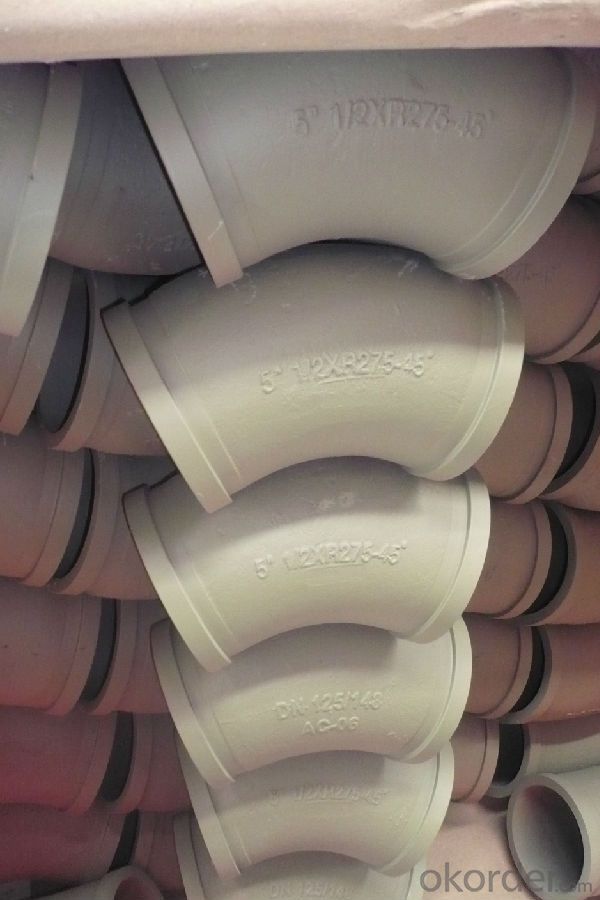

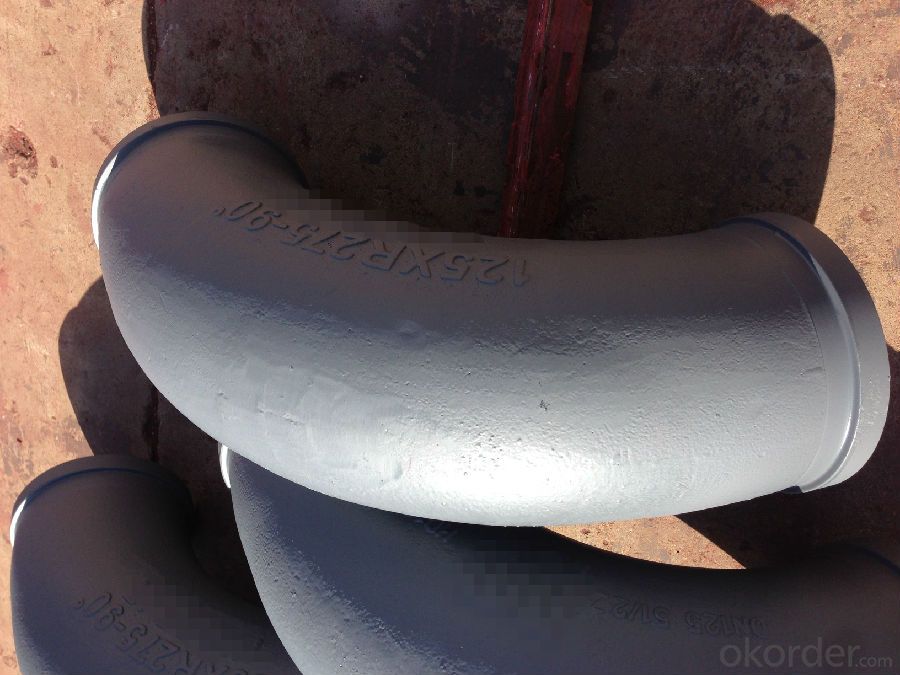
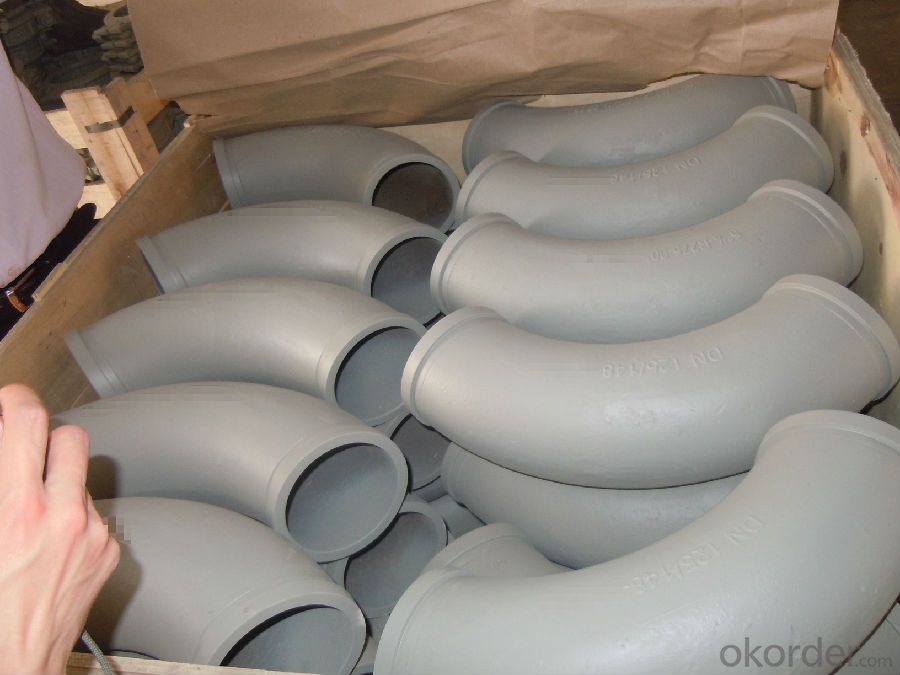
- Q: How do I determine the correct temperature ratings for concrete pump spare parts?
- To determine the correct temperature ratings for concrete pump spare parts, you need to consider the specific requirements and specifications of your concrete pump system. Here are some steps to help you in this process: 1. Consult the manufacturer's documentation: Start by reviewing the technical specifications provided by the manufacturer of your concrete pump system. The manufacturer should provide temperature ratings for different components and spare parts. Look for information on temperature limits, recommended operating temperature ranges, and any specific guidelines or restrictions related to temperature. 2. Identify critical components: Identify the key components of your concrete pump system that may be affected by temperature, such as hoses, seals, gaskets, valves, and electrical components. These components may have different temperature ratings depending on the materials used and their specific design. 3. Consider application conditions: Assess the operating conditions of your concrete pump system to determine the potential temperature extremes it may encounter. Factors such as ambient temperature, concrete mix temperature, and the presence of external heat sources (such as hot weather or nearby equipment) can affect the temperature of the system and its spare parts. 4. Check compatibility: Ensure that the spare parts you are considering have compatibility with the specific temperature range of your concrete pump system. Some components may have different ratings based on factors like chemical compatibility, thermal expansion, and resistance to heat transfer. 5. Seek expert advice: If you are uncertain about the temperature ratings or need further clarification, it is advisable to consult with professionals or experts in the field of concrete pump systems. They can provide specific recommendations based on their knowledge and experience. By following these steps and considering the manufacturer's guidelines and expert advice, you can determine the correct temperature ratings for concrete pump spare parts, ensuring the safe and efficient operation of your system.
- Q: Where can I buy concrete pump spare parts?
- Concrete pump spare parts can be purchased from various sources. One possibility is to contact the manufacturer of your concrete pump. Typically, they have authorized dealers or distributors who sell genuine spare parts for their equipment. This guarantees that the parts are of high quality and compatible with your specific pump model. Another option is to explore specialized construction equipment suppliers or dealers in your locality. These companies often carry a wide range of spare parts for different types and brands of concrete pumps. You may either visit their physical stores or browse their websites to check if they have the specific parts you require. Alternatively, online marketplaces and platforms offer a convenient way to buy concrete pump spare parts. Websites such as Amazon, eBay, and Alibaba have an extensive selection of spare parts from sellers worldwide. You have the opportunity to compare prices, read reviews, and select the parts that best meet your needs. Before finalizing your purchase, it is crucial to ensure that you are buying from a reputable source. Look for sellers with positive feedback or ratings, and verify if they provide warranties or return policies. Additionally, take into account factors like shipping costs, delivery times, and customer service when determining where to purchase your concrete pump spare parts.
- Q: Are there any specific guidelines for the disposal of old or damaged concrete pump spare parts?
- Old or damaged concrete pump spare parts must be disposed of according to specific guidelines. To ensure environmental sustainability and comply with local regulations, it is important to dispose of these parts properly. Here are some steps to follow: 1. Hazardous material identification: Prior to disposal, it is crucial to determine if the spare parts contain any hazardous materials such as oils, lubricants, or chemicals. These substances require special handling and cannot be disposed of in regular waste streams. 2. Separation of recyclable materials: If the spare parts are made of recyclable materials like metal or plastic, it is advisable to separate them from other waste. Recycling these materials helps conserve resources and reduces the strain on landfill sites. 3. Contact waste management authorities: Each region has its own guidelines and regulations for disposing of specific materials. It is recommended to reach out to local waste management authorities to understand the proper procedures for disposing of concrete pump spare parts in your area. 4. Arrange for proper disposal: Once hazardous materials have been identified and recyclable parts have been separated, make arrangements for their proper disposal. This may involve contacting specialized waste management companies that handle hazardous materials or taking them to designated recycling centers. 5. Avoid illegal dumping: It is essential to refrain from illegally dumping old or damaged concrete pump spare parts. This can harm the environment and may result in fines or penalties. Always dispose of these parts through legal and responsible channels. By adhering to these guidelines, you can ensure the appropriate disposal of old or damaged concrete pump spare parts, minimize environmental impact, and comply with local regulations.
- Q: Can concrete pump spare parts be customized for specific pump models?
- Yes, concrete pump spare parts can be customized for specific pump models. Concrete pumps come in various sizes and designs, and each model may have unique specifications and requirements for its spare parts. To ensure compatibility and optimal performance, it is important to customize the spare parts according to the specific pump model. This customization can include dimensions, materials, and other technical specifications that are tailored to fit the particular pump model. By customizing the spare parts, it ensures a perfect fit and enhances the efficiency and longevity of the concrete pump. Additionally, customization allows for potential improvements or modifications to the original design, resulting in enhanced performance and durability of the pump. Therefore, it is crucial to work with reputable manufacturers or suppliers who can provide customized concrete pump spare parts for specific pump models.
- Q: What are the signs of a damaged concrete pump accumulator?
- Some signs of a damaged concrete pump accumulator may include leaks or fluid seepage, reduced pump performance, irregular pressure readings, increased noise or vibration, and sudden pump shutdowns or malfunctions.
- Q: How can one identify the correct part number for a specific concrete pump spare part?
- To identify the correct part number for a specific concrete pump spare part, there are a few steps you can follow: 1. Check the equipment manual: The first place to look is the manual that came with the concrete pump. It should provide a detailed parts list along with their corresponding part numbers. This is the most reliable and accurate source of information. 2. Contact the manufacturer: If you don't have access to the equipment manual or if it doesn't provide the necessary information, reach out to the manufacturer directly. They should be able to assist you in identifying the correct part number for the specific concrete pump spare part you need. Provide them with as much information as possible, such as the make, model, and serial number of the concrete pump. 3. Use online resources: There are various online platforms and parts catalogs available that provide detailed information about spare parts for different concrete pump brands and models. These resources often allow you to search for the part based on the make and model of your concrete pump. Make sure to cross-reference the information you find with the manufacturer's specifications to ensure accuracy. 4. Consult with a local dealer or distributor: If you are unable to find the correct part number through the above methods, consider reaching out to a local dealer or distributor of concrete pump spare parts. They often have extensive knowledge and experience in identifying and sourcing the right parts for different equipment. Provide them with all the necessary details about your concrete pump, and they should be able to assist you in finding the correct part number. Remember, accuracy is crucial when identifying the correct part number for a specific concrete pump spare part. Using reliable sources and consulting with professionals will help ensure that you obtain the right part for your equipment's needs.
- Q: Are there any environmental considerations in the production of concrete pump spare parts?
- Yes, there are several environmental considerations in the production of concrete pump spare parts. Firstly, the manufacturing process of these parts typically involves the use of various materials and chemicals that can have negative environmental impacts. For example, the production of steel components may require the extraction of iron ore and the emission of greenhouse gases during the smelting process. Similarly, the production of rubber parts may involve the use of petroleum-based materials, which contribute to carbon emissions and pollution. Furthermore, the disposal of concrete pump spare parts after their useful life can also pose environmental challenges. If not properly managed, these parts can end up in landfills, contributing to waste accumulation and potential soil and water contamination. Therefore, it is important to consider the recyclability and reusability of these spare parts during their design and production stages. To address these environmental concerns, manufacturers can adopt sustainable practices in the production of concrete pump spare parts. This may involve incorporating recycled materials into the manufacturing process, such as using recycled steel or rubber. Additionally, manufacturers can implement efficient production techniques to minimize waste generation and reduce energy consumption. Proper waste management and recycling programs should also be established to ensure the responsible disposal of these spare parts at the end of their life cycle. Overall, by considering the environmental impacts associated with the production and disposal of concrete pump spare parts, manufacturers can contribute to a more sustainable and environmentally friendly industry.
- Q: How often should hopper agitator motors be inspected or replaced in a concrete pump?
- The inspection or replacement frequency of hopper agitator motors in a concrete pump relies on several factors, including usage intensity, operating conditions, and maintenance practices. However, as a general rule, it is advised to conduct regular inspections of hopper agitator motors every three to six months. Regular inspections can help identify any indications of wear and tear, damage, or malfunction in the motor. These issues may manifest as abnormal noise, excessive vibrations, overheating, or reduced performance. It is also important to check for loose or worn components like belts, pulleys, or bearings, as these can impact the motor's efficiency and lifespan. If any significant issues or malfunctions are discovered during the inspection, it may be necessary to replace the hopper agitator motor. The decision to replace the motor should be based on the severity of the problem, the motor's age, and the cost-effectiveness of repairs versus replacement. In addition to regular inspections, it is crucial to adhere to the manufacturer's recommendations for maintenance and lubrication of the hopper agitator motor. Proper maintenance practices can prolong the motor's lifespan and reduce the need for replacement. Ultimately, the specific frequency of inspections and replacement of hopper agitator motors in a concrete pump should be determined by considering the specific circumstances and conditions of the pump's operation, taking into account the manufacturer's guidelines and recommendations.
- Q: What are the key factors to consider when purchasing concrete pump spare parts?
- When purchasing concrete pump spare parts, it is important to consider factors such as the quality and reliability of the parts, compatibility with the specific model of the concrete pump, availability and affordability of the parts, as well as the reputation and customer reviews of the supplier or manufacturer. Additionally, factors like warranty, after-sales service, and the durability of the spare parts should also be taken into account.
- Q: How does a hopper agitator blade ensure smooth concrete flow?
- A hopper agitator blade ensures smooth concrete flow by constantly mixing and agitating the concrete inside the hopper. This prevents the concrete from settling or forming clumps, ensuring a consistent and even flow of the material. The agitation action of the blade also helps to break up any air pockets that may be present in the concrete, resulting in a more uniform and high-quality mixture.
Send your message to us
Concrete Pump ELBOW R275, 45DGR DN125MM Grey
- Loading Port:
- Tianjin
- Payment Terms:
- TT or LC
- Min Order Qty:
- 10 pc
- Supply Capability:
- 5000 pc/month
OKorder Service Pledge
OKorder Financial Service
Similar products
Hot products
Hot Searches
Related keywords
